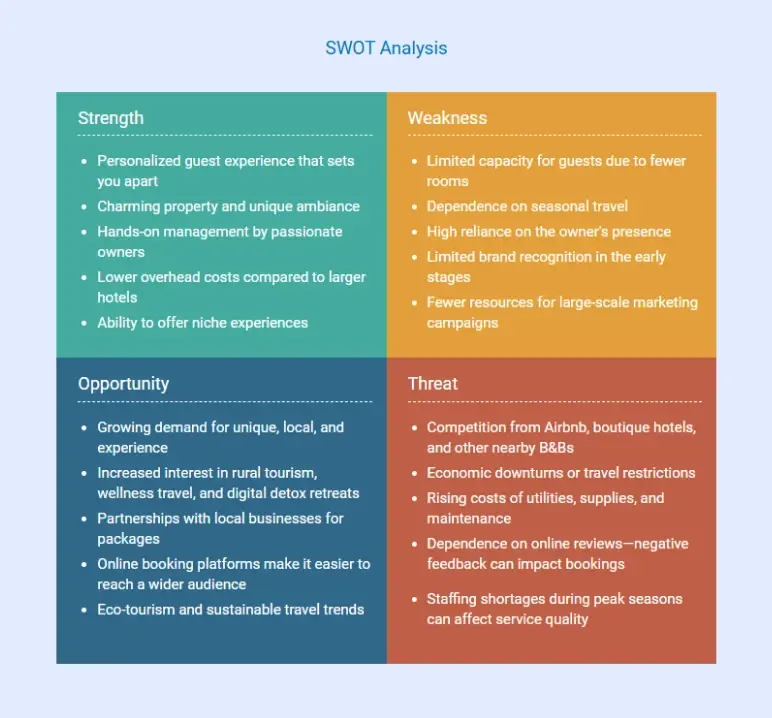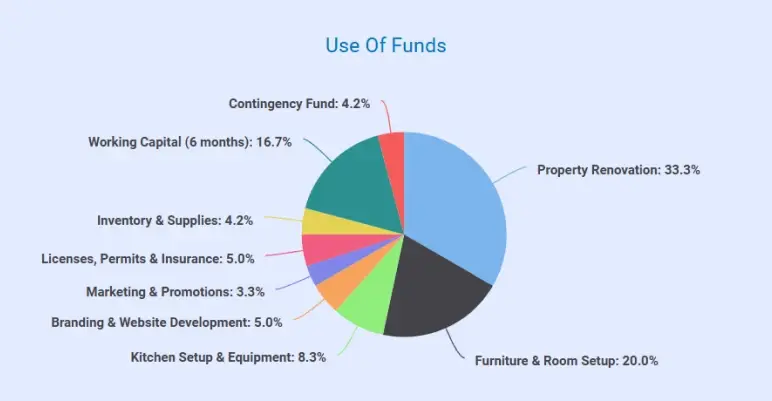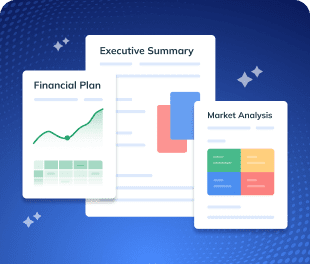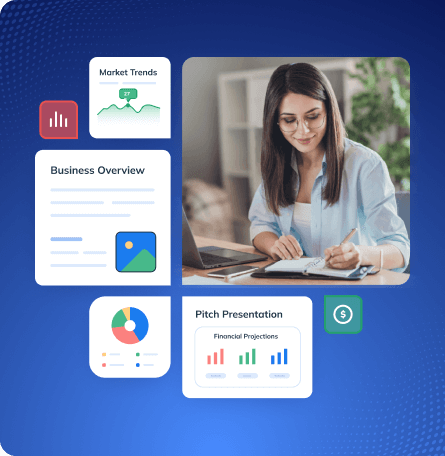You’ve been dreaming about opening your own bed and breakfast for a while now. Maybe it’s the idea of meeting new people each day, serving your favorite breakfast recipes, or finally making use of that extra space.
But it’s not just about charm and pancakes. It’s a real business!
And if you’re jumping in without a plan, things can get messy fast. You’ll end up guessing prices, scrambling to book rooms, and wondering where the money went.
So, you need a solid plan—it’s what keeps you organized and on track.
Not sure how draft one?
This bed and breakfast business plan template breaks it down into simple steps.
How to write a business plan for a bed and breakfast?
Follow this step-by-step guide to write a bed and breakfast business plan from scratch:
1. Executive Summary
The executive summary gives you a high-level overview of what your bed and breakfast business is all about. It briefly highlights what you offer, who you cater to, what sets you apart, and where you’re headed.
The goal here is to capture readers’ attention and make a great first impression. So, try to keep your plan summary clear, concise, and compelling.
Here’s what to include in this section:
- Business name and location
- Unique services
- Vision and mission statements
- Business goals
- Target market
- Financial snapshot
Though it’s the introductory part, it’s best to finalize it last. This will help you summarize the most essential aspects of your bed and breakfast from the rest of your plan without continuously going to and for. Overall, this section doesn’t need to tell the whole story.
Say goodbye to boring templates
Build your business plan faster and easier with AI
Plans starting from $14/month

2. Business Description
In the business overview section, you need to explain what kind of business you’re trying to build. Mention the details like its service, its legal structure, and how you’ll be positioning it in the market.
To plan this section, answer the following questions:
- Who owns the bed and breakfast? What’s their background in hospitality?
- What’s the legal structure of your business?
- Where is the business based? Are you operating remotely, from a physical location, or in a hybrid setup?
- What’s your core business model—nightly bookings, seasonal packages, event hosting, or partner-led experiences?
- What are your short-term priorities and long-term goals for growth?
Remember, this section doesn’t have to be impressive—just honest, informative, and well-organized.
3. Market Analysis
The market analysis section is dedicated to providing information about the external environment in which your business will operate.
Especially if you’re new in the industry, it’s important to understand the market you’re about to enter. This gives you a clear idea of who your ideal guests are, what they’re looking for in a stay, and what’s happening in the travel and hospitality industry.
Besides giving clarity, the main goal here is to convince the readers that the industry you’re targeting has a gap and that your business is capable of bridging it. You also need to back up your claims using the right data.
In this section, these are the following information you can’t miss out on:
- Industry outlook and growth forecast
- Local market overview
- Emerging trends
- Target market demographics
- Regulatory compliance
If required, give a detailed breakdown of primary customer segments for your bed and breakfast business, where every segment has different preferences. For example:
| Segment | Key Attributes | Needs & Preferences |
|---|---|---|
| Weekend Couples | From nearby cities, mid-income, looking to unwind | Cozy rooms, romantic atmosphere, nature access, privacy |
| Wellness Solo Travelers | Yoga, journaling, or hiking-focused individuals | Healthy meals, quiet spaces, access to trails or workshops |
| Remote Professionals | Digital nomads or hybrid workers | Reliable Wi-Fi, work-friendly amenities, longer-stay options |
| Retired Explorers | Travel-savvy seniors exploring local culture | Comfortable stay, homemade food, local experiences |
| Small Event Guests | Attendees of elopements, retreats, or family events | Group-friendly packages, flexible booking, local recommendations |
Understanding the different customer segments helps you tailor your services, seasonal offers, and overall marketing approach.
4. Competitive Analysis
Now, analyze your direct and indirect competitors and show potential investors how you’re going to compete with them.
In the bed and breakfast industry, most likely, your direct competitors will be boutique inns or other B&Bs. However, your indirect competitors might include vacation rentals like Airbnb and mid-range hotel chains with complementary breakfast options.
While there are several factors to consider when analyzing your competitors, these are some of the important ones you can’t miss out on:
Type of service offerings: Look at what each B&B provides—identify how you can make a difference.
Pricing strategy and service quality: Consider prices during different seasons and assess the service level based on customer reviews.
Primary customers: Figure out who they target—this allows you to look and observe whether you are catering to the same audience.
Occupancy rate or volume of bookings: Though you might not be aware of numbers, websites like TripAdvisor or Booking.com can inform you of how popular they are and if they have high demand.
After that, figure out what is unique about your bed and breakfast and highlight your competitive edge.
Moreover, perform a SWOT analysis that will help you highlight your business’s strengths, weaknesses, opportunities, and threats. For instance:

5. Marketing Strategy
Once you understand who your ideal audience is and how your competitors are positioned, you need to prepare a marketing strategy to attract them.
A good marketing plan defines the promotional strategies and sales techniques you will employ. It also enables you to monitor marketing costs, measure ROI, and adjust your strategy according to what proves most effective.
Here are a few strategies you may consider for marketing your bed and breakfast:
- Using social media platforms to share high-quality photos and videos focusing on your B&B.
- Building partnerships with local businesses like tour guides and event planners to create effective referral networks.
- Creating an SEO-optimized website with a booking engine to target location-based travel searches.
- Encouraging guests to leave genuine reviews on platforms like Google and TripAdvisor to build credibility and increase organic authority.
- Offering referral incentives for previously visited guests and local partners who refer new customers.
Your marketing strategy doesn’t need to be overly complicated, but it should show that you have a plan for building awareness, generating interest, and creating repeat customers.
6. Management Team and Organization
The management team section of your bed and breakfast business gives an overall view of the people responsible for growing your B&B. Whether you’re managing it alone or have a team, this section helps the readers understand how the business will be managed and by whom.
So, start by introducing yourself. Share your name, your role in the business, and a brief resume-style summary of your background. Include any relevant education, hospitality, or customer service experience you have.
Further, don’t forget to mention any transferable previous experience you bring to the table, such as customer service, team management, culinary skills, and so on.
If you have a co-owner, family member, or small team helping out, include them too. Outline what they’ll be responsible for. The goal is to give readers a clear picture of who’s doing what.
The ultimate goal of this section is to instill trust among potential investors, lenders, or partners and show that the business is in capable hands.
7. Operations Plan
The operations plan section provides a detailed look at how your bed and breakfast will function on a daily basis and how it will scale over time to meet its broader business goals.
This section bridges the gap between strategy and execution. It indicates how guest services will be provided, how resources and staffing will be allocated, and how your new business will have consistency.
Here, you can divide the section into two parts:
Day-to-day Procedures
Emphasize the routine activities that keep your B&B operational on a day-to-day basis. These may include answering booking calls, confirming bookings, checking in and out guests, preparing breakfast, cleaning rooms, replenishing supplies, and maintaining the property.
This will give readers a clear picture of what happens behind the scenes each day and how you ensure consistent quality for guests.
Specific Milestones
Use this part to outline your long-term goals. These may include achieving a specific occupancy percentage within a limited time frame, developing seasonal packages or retreat services, or hiring new employees.
In short, a well-structured operations plan will show lenders, investors, or partners that you understand not only how to create a great guest experience but also how to sustain and grow it over time.
8. Financial Plan
Now, let’s talk about financials in this section. You just need to show how much you’ll spend, how much you expect to earn, and when you’ll break even.
Creating realistic financial projections will help you or potential funders decide if your bed and breakfast is financially viable or not. So, try to enclose all the important financial information or statements for the next 3-5 years of operation.
Start with your start-up costs. These are one-time expenses to get your B&B up and running. This could include things like renovations, furniture, and decor for each room.
Next, list your monthly expenses. This includes regular costs like your mortgage or rent, electricity, water, internet, and food.
Then, figure out your expected income. Think about how many rooms you have, what you’ll charge per night, and how often you expect to be booked.
Once you have your income and expenses, you can create a 12-month projection of cash flow statements. This will help you see how much money is coming in and going out each month—and whether you’ll have a profit or a shortfall.
For better understanding, you can explore these given financial statements to create your own.
Income Statement
| Category | Amount (USD) |
|---|---|
| Revenue | |
| Room Revenue (5 rooms @ $120 avg. rate × 60% occupancy × 365 days) | $131,400 |
| Add-on Services (tours, packages, etc.) | $8,000 |
| Total Revenue | $139,400 |
| Operating Expenses | |
| Staff Wages (part-time help) | $18,000 |
| Breakfast Supplies | $7,200 |
| Utilities (electricity, water, internet) | $6,000 |
| Maintenance & Repairs | $3,000 |
| Cleaning Supplies & Laundry | $2,500 |
| Insurance | $2,000 |
| Marketing & Advertising | $4,000 |
| Booking Platform Fees | $3,500 |
| Miscellaneous Expenses | $2,000 |
| Total Operating Expenses | $48,200 |
| Net Profit (Before Tax) | $91,200 |
Cash Flow Statement
| Category | Amount (USD) |
|---|---|
| Cash Inflows | |
| Cash from Room Bookings | $131,400 |
| Cash from Add-on Services | $8,000 |
| Owner’s Capital Contribution | $20,000 |
| Loan Proceeds (if applicable) | $30,000 |
| Total Cash Inflows | $189,400 |
| Cash Outflows | |
| Property Renovation & Setup | $20,000 |
| Furniture & Equipment | $12,000 |
| Website & Branding | $3,000 |
| Licenses & Permits | $1,500 |
| Working Capital (Ops) | $48,200 |
| Loan Repayments | $6,000 |
| Emergency/Contingency Spend | $2,000 |
| Total Cash Outflows | $92,700 |
| Net Cash Flow | $96,700 |
| Opening Cash Balance | $0 |
| Closing Cash Balance | $96,700 |
Balance Sheet
| Assets | |
|---|---|
| Category | Amount (USD) |
| Current Assets | |
| Cash (Closing Balance) | $96,700 |
| Account Receivable (if any) | $1,000 |
| Prepaid Expenses (insurance, etc.) | $500 |
| Total Current Assets | $98,200 |
| Non-Current Assets | |
| Property Improvements | $20,000 |
| Furniture & Equipment | $12,000 |
| Website & Branding | $3,000 |
| Total Non-Current Assets | $35,000 |
| Total Assets | $133,200 |
| Liabilities and Owner’s Equity | |
|---|---|
| Category | Amount (USD) |
| Liabilities | |
| Loan Payable (Year-End Balance) | $24,000 |
| Account Payable | $1,200 |
| Total Liabilities | $25,200 |
| Owner’s Equity | |
| Owner’s Capital Investment | $20,000 |
| Retained Earnings (Net Profit) | $88,000 |
| Total Owner’s Equity | $108,000 |
| Total Liabilities & Equity | $133,200 |
Finally, estimate your break-even point. This is when your income will cover your monthly expenses. Knowing when you’ll break even helps you stay realistic about how long it will take to become profitable.
9. Funding Request
This section is all about how much money your bed and breakfast business needs and why you need it. Keep it specific, realistic, and focused on essentials.
It also shows lenders and investors that you’ve carefully thought through your costs and have a responsible plan for how you’ll use the money.
Start by stating the total amount of funding you’re seeking and where you plan to get it from. Possible funding sources might include:
- Personal savings and family contributions
- Small Business Administration (SBA) loans
- Traditional bank loans
- Private investors
- Crowdfunding campaigns
Further, explain how you’ll use the funds, as investors and lenders want to know exactly where their money will go and how it supports your success. For instance:

If you’ve already secured part of the funding, include that too. Showing a personal investment adds credibility and demonstrates commitment.
Why is a bed and breakfast business plan essential?
A bed and breakfast business plan will help you establish your guest experience, room inventory, pricing strategy, marketing strategy, and operational process. It will also lay out how you will bring in travelers, maintain a consistent quality of service, handle daily operations, and grow sustainably over time.
Besides, with a detailed plan of action in hand, it becomes easier to estimate major expenses—such as property maintenance, staff, basic utilities, breakfast options, and seasonal marketing against realistic financial projections.
Whether you’re applying for a small business loan or simply laying the groundwork, your business plan shows that you’ve thought through every detail for running your business smoothly.
Download a free bed and breakfast business plan template
Need help writing your own bed and breakfast business plan from scratch? Worry not! Here you go—download our free bed and breakfast business plan PDF to get started.
It’s a professionally designed business plan template created specifically for bed and breakfast owners and aspiring hosts. Use this example as a reference while writing your own plan. You can also customize it to suit your unique business goals.
The Quickest Way to turn a Business Idea into a Business Plan
Fill-in-the-blanks and automatic financials make it easy.
Conclusion
Let’s wrap it up! We’ve covered every essential section of a bed and breakfast business plan—from defining your vision and services to mapping out your operations, finances, and growth strategy. You also got access to a free sample plan to help bring it all together.
Whether you’re starting from scratch or refining an existing idea, a solid plan gives you the clarity and confidence to move forward.
But if you’d prefer to skip the formatting headaches and get straight to a professional, polished plan, Upmetrics can help. It’s an AI-powered business planning software that helps you create a detailed business plan quickly, including thorough market research and accurate financial forecasting.
So, wait no longer; give Upmetrics a try!



